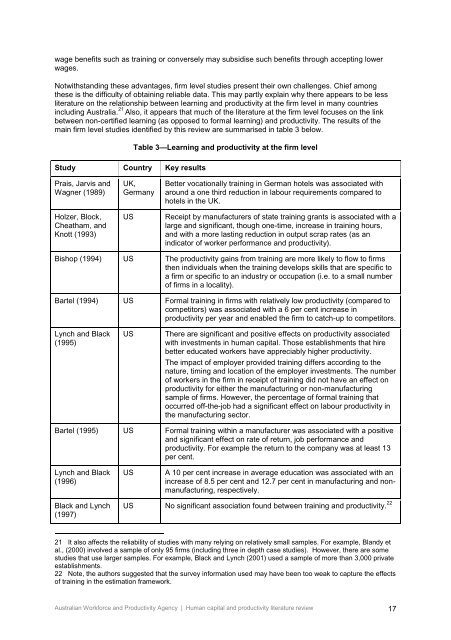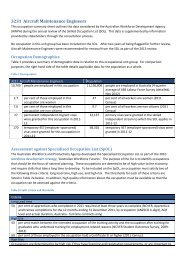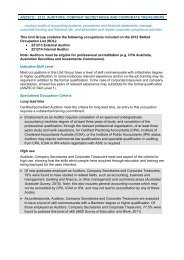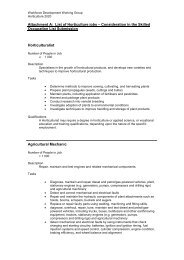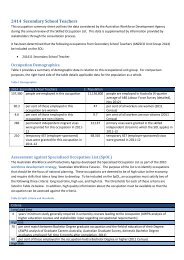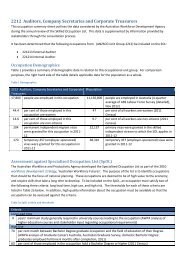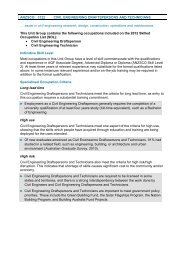Human capital and productivity - AWPA
Human capital and productivity - AWPA
Human capital and productivity - AWPA
- No tags were found...
You also want an ePaper? Increase the reach of your titles
YUMPU automatically turns print PDFs into web optimized ePapers that Google loves.
wage benefits such as training or conversely may subsidise such benefits through accepting lowerwages.Notwithst<strong>and</strong>ing these advantages, firm level studies present their own challenges. Chief amongthese is the difficulty of obtaining reliable data. This may partly explain why there appears to be lessliterature on the relationship between learning <strong>and</strong> <strong>productivity</strong> at the firm level in many countriesincluding Australia. 21 Also, it appears that much of the literature at the firm level focuses on the linkbetween non-certified learning (as opposed to formal learning) <strong>and</strong> <strong>productivity</strong>. The results of themain firm level studies identified by this review are summarised in table 3 below.Table 3—Learning <strong>and</strong> <strong>productivity</strong> at the firm levelStudy Country Key resultsPrais, Jarvis <strong>and</strong>Wagner (1989)Holzer, Block,Cheatham, <strong>and</strong>Knott (1993)UK,GermanyUSBetter vocationally training in German hotels was associated witharound a one third reduction in labour requirements compared tohotels in the UK.Receipt by manufacturers of state training grants is associated with alarge <strong>and</strong> significant, though one-time, increase in training hours,<strong>and</strong> with a more lasting reduction in output scrap rates (as anindicator of worker performance <strong>and</strong> <strong>productivity</strong>).Bishop (1994) US The <strong>productivity</strong> gains from training are more likely to flow to firmsthen individuals when the training develops skills that are specific toa firm or specific to an industry or occupation (i.e. to a small numberof firms in a locality).Bartel (1994) US Formal training in firms with relatively low <strong>productivity</strong> (compared tocompetitors) was associated with a 6 per cent increase in<strong>productivity</strong> per year <strong>and</strong> enabled the firm to catch-up to competitors.Lynch <strong>and</strong> Black(1995)USThere are significant <strong>and</strong> positive effects on <strong>productivity</strong> associatedwith investments in human <strong>capital</strong>. Those establishments that hirebetter educated workers have appreciably higher <strong>productivity</strong>.The impact of employer provided training differs according to thenature, timing <strong>and</strong> location of the employer investments. The numberof workers in the firm in receipt of training did not have an effect on<strong>productivity</strong> for either the manufacturing or non-manufacturingsample of firms. However, the percentage of formal training thatoccurred off-the-job had a significant effect on labour <strong>productivity</strong> inthe manufacturing sector.Bartel (1995) US Formal training within a manufacturer was associated with a positive<strong>and</strong> significant effect on rate of return, job performance <strong>and</strong><strong>productivity</strong>. For example the return to the company was at least 13per cent.Lynch <strong>and</strong> Black(1996)USA 10 per cent increase in average education was associated with anincrease of 8.5 per cent <strong>and</strong> 12.7 per cent in manufacturing <strong>and</strong> nonmanufacturing,respectively.Black <strong>and</strong> Lynch(1997)US No significant association found between training <strong>and</strong> <strong>productivity</strong>. 2221 It also affects the reliability of studies with many relying on relatively small samples. For example, Bl<strong>and</strong>y etal., (2000) involved a sample of only 95 firms (including three in depth case studies). However, there are somestudies that use larger samples. For example, Black <strong>and</strong> Lynch (2001) used a sample of more than 3,000 privateestablishments.22 Note, the authors suggested that the survey information used may have been too weak to capture the effectsof training in the estimation framework.Australian Workforce <strong>and</strong> Productivity Agency | <strong>Human</strong> <strong>capital</strong> <strong>and</strong> <strong>productivity</strong> literature review 17


